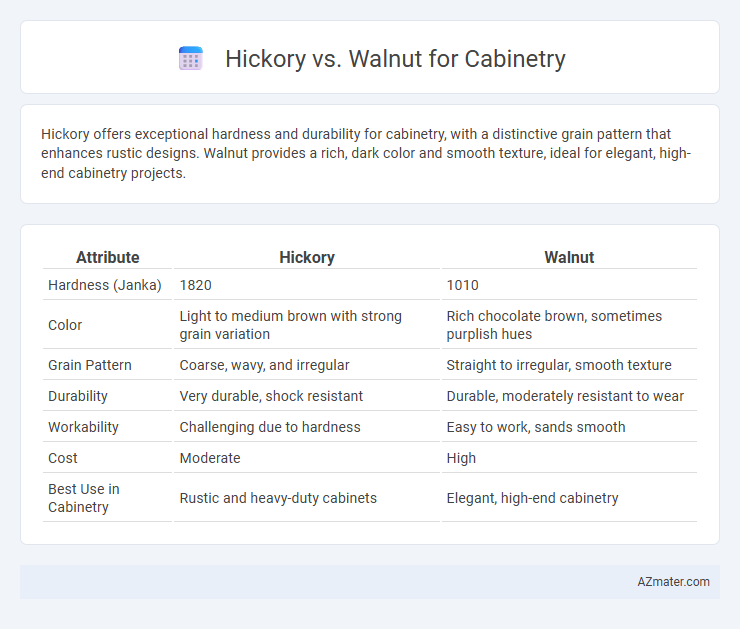Hickory offers exceptional hardness and durability for cabinetry, with a distinctive grain pattern that enhances rustic designs. Walnut provides a rich, dark color and smooth texture, ideal for elegant, high-end cabinetry projects.
Table of Comparison
| Attribute | Hickory | Walnut |
|---|---|---|
| Hardness (Janka) | 1820 | 1010 |
| Color | Light to medium brown with strong grain variation | Rich chocolate brown, sometimes purplish hues |
| Grain Pattern | Coarse, wavy, and irregular | Straight to irregular, smooth texture |
| Durability | Very durable, shock resistant | Durable, moderately resistant to wear |
| Workability | Challenging due to hardness | Easy to work, sands smooth |
| Cost | Moderate | High |
| Best Use in Cabinetry | Rustic and heavy-duty cabinets | Elegant, high-end cabinetry |
Introduction: Hickory vs Walnut Cabinets
Hickory cabinets offer a distinctively bold grain pattern and exceptional hardness, making them highly durable for high-traffic kitchen environments. Walnut cabinets feature a rich, dark brown color with smooth, consistent grain that adds elegance and warmth to any space. Choosing between Hickory and Walnut cabinets depends on desired aesthetics, durability requirements, and budget considerations.
Distinctive Appearance and Grain Patterns
Hickory cabinets feature a bold, rustic appearance with dramatic color variations ranging from creamy whites to rich browns, showcasing a highly varied and pronounced grain pattern that highlights knots and unique character marks. Walnut offers a more refined, elegant look with a consistent chocolate brown tone and subtle, straight grains that create a smooth, sophisticated surface ideal for contemporary or traditional cabinetry. Choosing between Hickory and Walnut depends on the desired style, whether emphasizing natural ruggedness or a sleek, polished finish.
Color Variations: Warmth and Richness
Hickory cabinetry features a wide spectrum of color variations, ranging from pale creamy tones to deep reddish-browns, offering a natural warmth that enhances rustic and traditional kitchen designs. Walnut stands out with its rich, dark chocolate hues and subtle purple undertones, delivering a sophisticated and elegant ambiance ideal for modern or classic styles. The contrasting color palettes of hickory and walnut provide distinct visual textures, allowing homeowners to select cabinetry that best complements their desired warmth and richness in interior decor.
Durability and Hardness Comparison
Hickory exhibits a Janka hardness rating of around 1,820, making it one of the hardest domestic hardwoods available, ideal for cabinetry that demands superior durability and resistance to dents and scratches. Walnut, with a Janka hardness of approximately 1,010, offers moderate hardness and durability but excels in workability and rich color variations, making it suitable for cabinetry where aesthetics are prioritized over extreme toughness. For high-traffic kitchen cabinets requiring long-lasting resistance to wear and impact, hickory outperforms walnut, while walnut remains a top choice for elegant, less demanding cabinet applications.
Cost Differences: Budget Considerations
Hickory cabinetry typically costs less than walnut, making it a more budget-friendly option for homeowners seeking durability and a rustic aesthetic. Walnut's premium pricing reflects its rich color, fine grain, and higher demand in luxury cabinetry markets. Budget considerations should weigh the initial investment against long-term value, as walnut cabinets often retain higher resale value despite the steeper upfront cost.
Maintenance and Longevity
Hickory cabinets require regular sealing and occasional sanding to maintain their durability and prevent wear due to their dense grain and natural variations. Walnut offers superior longevity with less frequent maintenance, benefiting from its natural resistance to decay and stability in varying humidity. Both woods provide durable cabinetry, but walnut's tighter grain reduces the risk of cracking and warping over time, ensuring a longer-lasting finish.
Finishing Options and Stain Compatibility
Hickory offers a robust grain pattern that readily accepts a wide range of stains, from light honey tones to deep espresso finishes, allowing for versatile cabinetry styles. Walnut features a naturally rich, dark color with subtle grain variations, often enhanced by clear finishes or oil stains to preserve its luxurious appearance while providing excellent durability. Both woods require proper surface preparation to ensure stain uniformity, but walnut's smooth texture promotes even absorption, whereas hickory's varied grain may create a more rustic, textured finish.
Design Styles: Traditional vs Modern
Hickory cabinets bring a rustic, traditional charm with their pronounced grain patterns and warm, golden tones, making them ideal for classic, farmhouse, or country-style kitchens. Walnut offers a sleek, modern aesthetic with its smooth texture and rich, dark brown hues, perfect for contemporary and minimalist design schemes. Choosing between hickory and walnut depends on whether a bold, textured look or a refined, elegant finish better complements your cabinetry style.
Sustainability and Environmental Impact
Hickory cabinetry offers a sustainable option due to its rapid growth rate and wide availability, reducing deforestation pressure. Walnut, while prized for its rich color and grain, grows slower and is often sourced from less abundant forests, increasing its environmental footprint. Choosing FSC-certified hickory or walnut ensures responsible harvesting practices and supports sustainable forestry.
Choosing the Right Wood for Your Cabinets
Hickory offers exceptional hardness and a striking grain pattern, making it ideal for durable cabinetry with a rustic or country aesthetic. Walnut provides a rich, dark tone with smooth texture, perfect for elegant, high-end cabinets that emphasize sophistication and warmth. Selecting between hickory and walnut depends on desired durability, design style, and budget preferences, with hickory suiting robust use and walnut offering luxury appeal.

Infographic: Hickory vs Walnut for Cabinetry
 azmater.com
azmater.com